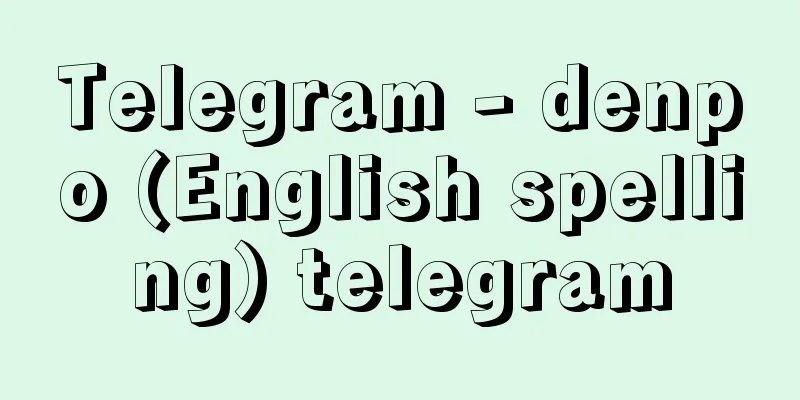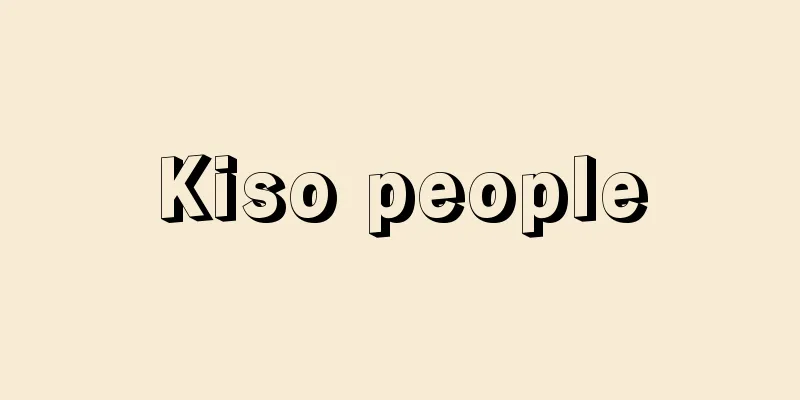Telegram - denpo (English spelling) telegram

|
A service in which communication content is transmitted by electrical communication means and then printed on paper or other media for delivery. It has also been called a telegraph. It differs from other electrical communication services in that it delivers a record of text rather than voice as with a telephone, and that it can be used by users without the need for equipment. It can also refer to communication content sent by telegram. Its features include its simplicity, ease of use, speed in reaching the recipient, and the evidential value of a paper record. It was one of the earliest forms of electrical communication. [Tetsuya Kasai] historyTelegraphs, based on the telegraph machine created in 1837 by S.F.B. Morse, an American known for the invention of Morse code, became popular for government, press, and railroad use, and also for the general public. In the United States, it started as a private business, but in many countries it has been run as a national business. In Japan, the government began handling domestic telegrams between Tokyo and Yokohama on January 26, 1870 (December 25, 1869, in the lunar calendar), and in 1871, the Great Northern Telegraph Company (headquartered in Denmark) began handling international telegrams between Nagasaki and Shanghai and between Nagasaki and Vladivostok. There were some obstacles at first, but it quickly spread throughout the country as part of the communication network essential to the modernization of the nation. The telegraph business has passed from being directly managed by the government to being managed by Nippon Telegraph and Telephone Public Corporation (now part of the Nippon Telegraph and Telephone Corporation group) and International Telegraph and Telephone Company (now KDDI), and is now only available to the successors of these two companies. [Tetsuya Kasai] Types and usageIn addition to regular telegrams (general telegrams, congratulatory and condolence telegrams), there are emergency telegrams, which can only send certain template text, and wireless telegrams used between ships. Telegrams can be sent by calling an office, or by telephone, fax, or over the Internet. Early telegrams sent Morse code as electrical signals, and the receiver translated the long and short sounds into letters and numbers before delivering them. Later, this method changed to sending electrical signals using paper tape with holes corresponding to letters. Furthermore, telegrams could be received and sent simultaneously, eliminating the need for paper tape and making it possible to send standard text written horizontally using Chinese characters. Furthermore, wired electrical communication was initially used to send electrical signals, but wireless communication later came into use. Currently, coaxial cable, optical fiber, and satellite communication are also used. Telegrams were once considered the most common means of emergency communication, but with the spread of other telecommunication services such as telephone, facsimile, and data communications, the number of telegrams used has dropped significantly. In terms of the nature of their use, telegrams are now mostly used for celebrations and condolences. In the telegram business, integration with other media is being promoted through relay exchanges, automation of processing systems, etc. Also, high-value-added telegrams such as melody telegrams that play a melody when opened and telegrams containing pressed flowers are now available. [Tetsuya Kasai] Telegram-like servicesFollowing the enforcement of the Letter Delivery Law in April 2003, a number of specified letter delivery businesses have entered the market, offering a telegram-like service in which messages received via telephone or the Internet are printed out, attached to a cardboard sheet, and delivered to the intended recipient. [Tetsuya Kasai] "Ministry of Internal Affairs and Communications, 'Information and Communications White Paper', various editions (Gyosei. Until the 2000 edition, it was 'Communications White Paper', compiled by the Ministry of Posts and Telecommunications)" [References] | | | | | | |Source: Shogakukan Encyclopedia Nipponica About Encyclopedia Nipponica Information | Legend |
|
通信内容を電気通信手段で伝送し、紙などに印刷して配達するサービス。電信といわれたこともある。電話のように音声ではなく文字などの記録が届く点と、利用者が設備をもたなくても利用できる点が他の電気通信サービスと異なる。電報で送られた通信内容をさすこともある。手軽に利用できる簡易性、受取人に速く届く迅速性、記録が紙面に残る証拠性といった特徴をもつ。電気通信手段としてはもっとも早くから利用された。 [笠井哲哉] 歴史電報は、モールス符号の発明者として知られているアメリカ人S・F・B・モースが1837年に作製した電信機をもとにして、政府、報道、鉄道などの業務用として普及し、さらに一般の人々にも広く利用されるようになった。アメリカでは民営事業として始まったが、多くの諸国では国営事業として経営されてきた。日本では1870年1月26日(明治2年12月25日=旧暦)に東京―横浜間で国内電報の取扱いが政府の手で始まり、1871年には長崎―上海(シャンハイ)間および長崎―ウラジオストク間で国際電報の取扱いが大北(たいほく)電信会社(本社デンマーク)によって始められた。当初は妨害もあったが、その後、国家近代化に不可欠な通信網の一部として急速に全国へ普及した。電報事業の経営は、政府直営から日本電信電話公社(現、日本電信電話株式会社グループ)と国際電信電話株式会社(現、KDDI)の経営の時代を経て、両社の後継会社のみが提供できるものとされている。 [笠井哲哉] 種類と利用状況電報の種類には、通常電報(一般電報、慶弔電報)のほかに、一定の文例のみを送ることができる緊急定文電報、船舶との間で使われる無線電報がある。 電報の発信方法としては、取扱い窓口に申し込むほか、電話、ファクシミリ、インターネットを通じて発信することもできる。 初期の電報は、電気信号でモールス符号を送り、受信側では音の長短を文字や数字に翻訳して配達した。その後、文字などに対応する穴をあけた紙テープを利用して電気信号を送る方式にかわった。さらに、電報の受付と送信を同時に行い、紙テープが不要になるとともに、漢字を使った横書きの定例文も送ることができるようになった。また、電気信号を送る方法として最初は有線電気通信が使われたが、のちには無線通信も使われるようになった。現在は、同軸ケーブル、光ファイバー、衛星通信なども使われている。 電報は緊急通信手段の代表とされていたが、電話、ファクシミリ、データ通信など他の電気通信サービスの普及に伴い、利用数が大幅に減少している。また、利用の内容では慶弔用のものが大部分を占めている。 電報事業では、中継交換、処理システムの自動化などを通じて、他メディアとの融合が進められている。また、電報を開くとメロディが聞こえてくるメロディ電報や、押し花入り電報など付加価値の高いものも利用できるようになっている。 [笠井哲哉] 電報類似サービス2003年(平成15)4月の信書便法施行に伴い、電話やインターネット等により受け付けたメッセージ等を印刷し、台紙に添付などして宛先まで配達する電報類似サービスを提供する、特定信書便事業者が参入している。 [笠井哲哉] 『総務省編『情報通信白書』各年版(ぎょうせい。平成12年版までは郵政省編『通信白書』)』 [参照項目] | | | | | | |出典 小学館 日本大百科全書(ニッポニカ)日本大百科全書(ニッポニカ)について 情報 | 凡例 |
Recommend
Kurukshetra (English spelling)
A Hindu pilgrimage site in the eastern part of Har...
'abd (English spelling) abd
…Compared to the Japanese theories, the period is...
Scutellaria indica; skullcap
A perennial plant of the Lamiaceae family, it is w...
Deontology - Gimuron (English spelling)
A coined word combining the Greek words deon (duty...
Coming of age ceremony
Genbuku is also called 'genbuku', 'ka...
Bikini (English spelling)
An atoll in the northwest of the Marshall Islands ...
geocentric latitude
...the angle between this vertical line and the e...
Friends - Tomodachi
A person who trusts others and interacts with them...
history
…the word history comes from the Greek word histo...
Countable infinity
...In that case, we can define it as "a set ...
Anglo-Norman [species] - Anglo-Norman
… [Intermediate species] A classification unique ...
Cesare Lombroso
Italian physician. Renowned as the founder of cri...
fieldaws
...Refers to an area on a site that is planned fo...
Gautier
French poet, writer, and critic. He initially aspi...
Omiya-in Temple
Fujiwara Kisshi was the Empress of the 88th Emper...









